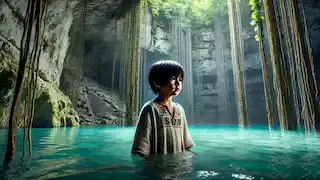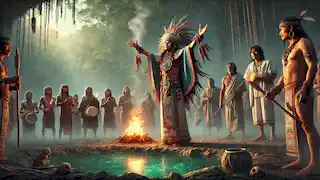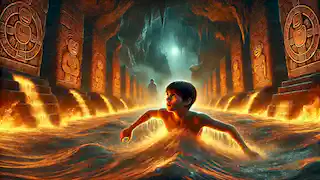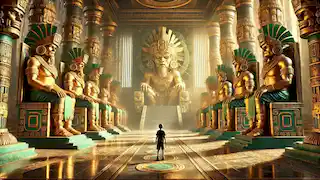Beneath the dense emerald canopy of the Yucatán Peninsula lies an ancient and enigmatic world, where whispers of the past blend with the hum of nature. This is the realm of the sacred cenote—an otherworldly sinkhole revered by the ancient Maya. For centuries, these natural wonders served as portals to the divine, their depths echoing with prayers and sacrifices meant to appease the gods. It is here, in the heart of a forgotten jungle, that our story begins—a tale of courage, betrayal, and the unbreakable bond between humanity and the unseen forces of the universe. In a small Mayan village nestled between the ceiba trees and the ruins of their ancestors, the boy Itzamná stood at the edge of the sacred cenote. The turquoise water glimmered in the filtered sunlight, casting eerie shadows on the surrounding limestone walls. Itzamná had heard the elders speak of the cenote as a bridge between the mortal world and Xibalba—the Mayan underworld. Legends said it was here the gods would hear the cries of the people and grant their wishes—or their doom. “I shouldn’t be here,” Itzamná whispered to himself. His black hair clung to his forehead, damp with the heat of the day. His heart pounded, not from fear of the gods, but from his disobedience to the village rules. The cenote was forbidden ground. He had not come for mischief but to see for himself the wonder that his mother spoke of so often. She told stories of how, as a young girl, she had been chosen to dance at the cenote’s edge during a grand ceremony. That dance had been her offering, a gift of movement and beauty to Chaac, the rain god, who blessed their lands with life-giving rain. But those days of prosperity had waned. The village, once thriving with fields of maize and cacao, was now a shadow of its former glory. The rains had ceased, and the gods had turned their faces away. That night, as Itzamná crept back to his hut, the village shaman, Ah Chuy Kak, summoned the people to the central plaza. Smoke from burning copal resin filled the air as villagers gathered, their faces etched with weariness and hope. “A vision has come to me!” the shaman proclaimed, his voice rising over the crackle of the fire. His milky eyes stared into the flames as if they spoke to him directly. “Chaac demands an offering. A pure soul must enter the cenote and seek the gods’ mercy. Only then will the rains return.” Whispers rippled through the crowd. Parents clutched their children tightly, eyes darting to avoid the shaman’s gaze. Itzamná’s stomach churned. He felt an inexplicable pull, as though the cenote had marked him during his forbidden visit. As the shaman’s eyes scanned the villagers, they rested on Itzamná. A cold smile spread across his weathered face. “You,” he said, pointing. “The gods have chosen you.” The following day, preparations began. Itzamná was adorned with jade beads and a white tunic embroidered with glyphs meant to protect him from the spirits of Xibalba. His mother wept quietly, her hands trembling as she fastened a feathered headdress onto his head. “You are brave, my son,” she whispered. “The gods will see your heart and bless us all.” The villagers gathered at the cenote, their faces solemn. Itzamná stood at the edge, gazing into the crystalline depths. A stone platform jutted over the water, and on it rested a carved obsidian dagger, its blade gleaming ominously. Ah Chuy Kak raised his arms, chanting in a language older than the trees themselves. The air grew heavy, the weight of unseen eyes pressing on Itzamná’s shoulders. With a final prayer, Itzamná stepped forward, clutching the dagger. He took a deep breath and dove into the cenote. The water embraced him like a cocoon, cool and still. As he sank deeper, light faded, and the world above disappeared. Shapes flickered in the darkness—ghostly silhouettes of those who had been sacrificed in ages past. Their voices were faint, murmuring in a tongue Itzamná could not understand. Suddenly, the water seemed to drain away, and he found himself standing in a vast cavern. Bioluminescent moss clung to the walls, casting an ethereal glow. Before him stood a massive stone doorway inscribed with glyphs pulsating with a soft, golden light. “You have come,” a voice echoed. Itzamná turned to see a figure emerge from the shadows. It was not human but a godly apparition with the form of a jaguar and eyes that burned like molten gold. “I am Chaac’s messenger,” the figure said. “You seek the gods’ favor, but to earn it, you must prove your worth.” Itzamná was led through the doorway into a labyrinth of challenges. The first was a chamber filled with obsidian spikes rising from the floor. “Only those who tread lightly may pass,” the jaguar said. With each step, Itzamná’s heart raced. The slightest misstep would mean certain death. He balanced on narrow stones, his small frame trembling but determined. Finally, he reached the end, his feet aching but intact. The next chamber was a river of fire. “Swim through and do not look back,” the jaguar instructed. Heat seared his skin as he plunged into the molten current. It was not water but something thicker, alive with an otherworldly energy. Each stroke felt like an eternity, but he pressed on, driven by the image of his mother’s face. The final trial was one of spirit. Itzamná stood before a mirror-like pool that reflected not his image but his fears. He saw the village burning, his family perishing in the drought, and himself lost in the abyss of Xibalba. “Face them,” the jaguar commanded. Closing his eyes, Itzamná took a deep breath and stepped into the pool. The images engulfed him, but instead of succumbing to despair, he remembered his purpose. He was here not for himself but for his people. Emerging from the pool, Itzamná found himself in a grand hall. Thrones of jade and gold lined the walls, and seated upon them were the gods. Chaac sat at the center, his visage as fierce as the storms he commanded. “You have shown courage, selflessness, and resolve,” Chaac said, his voice like thunder. “For this, the rains shall return. But know this: the bond between mortals and gods is fragile. Honor it, or face the consequences.” With a wave of Chaac’s hand, Itzamná felt a rush of water envelop him. When he opened his eyes, he was back in the cenote, floating under the starlit sky. The village celebrated Itzamná’s return with dances, feasts, and prayers of gratitude. The next morning, dark clouds gathered on the horizon, and rain fell in torrents, soaking the parched earth. Fields blossomed once more, and the people prospered. Years later, Itzamná grew into a wise leader, his experiences shaping his every decision. He often returned to the cenote, not to ask for more but to give thanks, ensuring the gods’ favor remained upon his people. And so, the tale of the sacred cenote became a story passed down through generations, a reminder of the enduring connection between humanity and the divine.The Forgotten Jungle

A Prophecy Unveiled
The Journey Begins
Into the Underworld
The Trials of Xibalba

The Gods’ Judgment
The Rain Returns


The Tale of the Sacred Cenote
Reading Time: 7 min

About Story: The Tale of the Sacred Cenote is a Myth Stories from mexico set in the Ancient Stories. This Descriptive Stories tale explores themes of Courage Stories and is suitable for . It offers Cultural Stories insights. Dive into the heart of the Yucatán jungle in "The Tale of the Sacred Cenote", where a young boy, Itzamná, embarks on a perilous journey to appease the gods and save his drought-stricken village. Facing ancient trials and the mysterious depths of the cenote, he discovers courage, selflessness, and the fragile bond between mortals and the divine. A story of sacrifice, resilience, and hope, this Mayan legend will immerse you in a world of myth, mystery, and timeless wisdom.
















